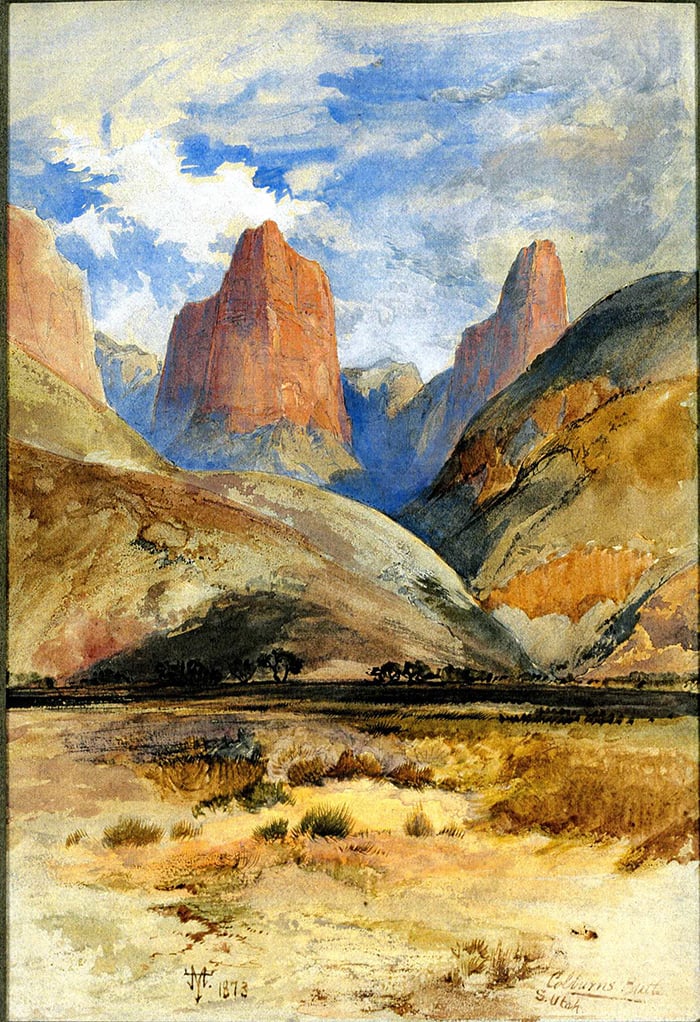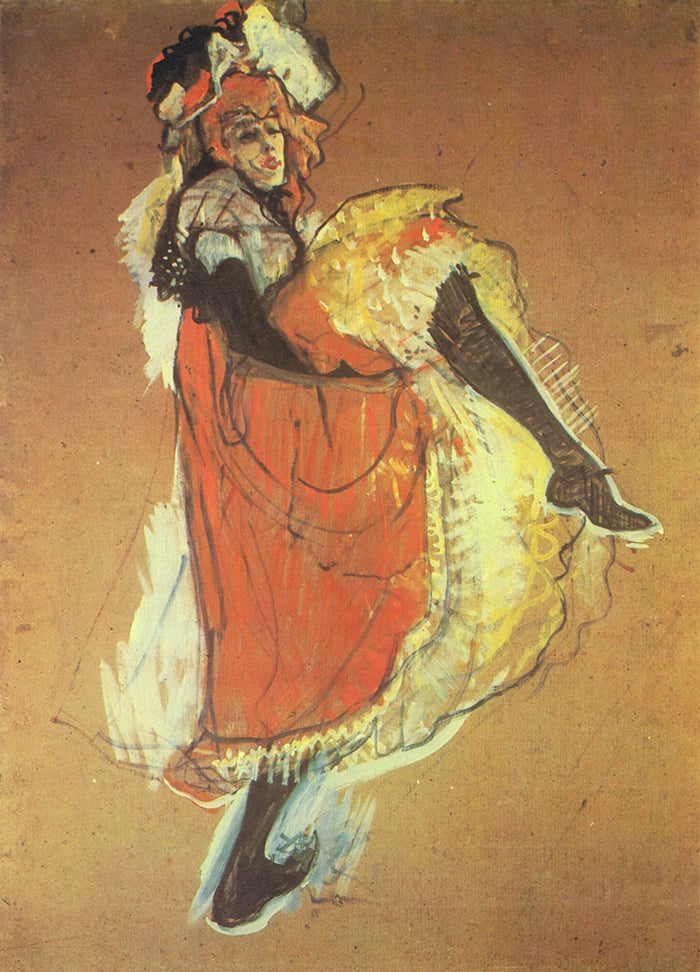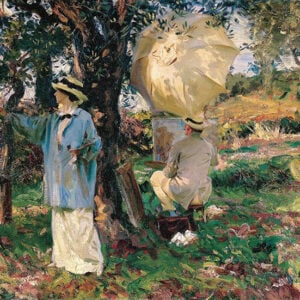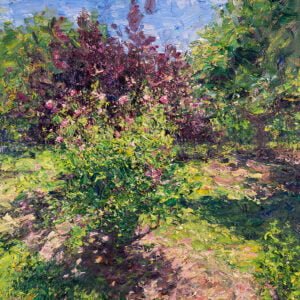The technique of gouache has been around since ancient times. However, the term was first used in 18th-century France to describe a type of opaque paint made from pigments bound in water-soluble gum. Over time, the unique qualities of gouache resulted in its growing popularity. In particular, plein air artists and illustrators increasingly used it over their watercolors, ink or pencil drawings and pastels. In this post, we explore who are ten of the most talented gouache artists from the 18th to the 20th century.
- 1. François Boucher (1703-1770)
- 2. Joseph Mallord William Turner (1775-1851)
- 3. Adolph Menzel (1815-1905)
- 4. Camille Pissarro (1830-1903)
- 5. Fidelia Bridges (1834-1923)
- 6. Thomas Moran (1837-1926)
- 7. Albert Beck Wenzell (1864-1917)
- 8. Henri de Toulouse Lautrec (1864-1901)
- 9. Henri Matisse (1869-1954)
- 10. Egon Schiele (1890-1918)
- Key Takeaways
- Want to Learn More?
- Thanks for Reading!
1. François Boucher (1703-1770)
François Boucher was a Rococo artist who contributed to the dissemination of this style throughout Europe. He did everything from oil and cabinet paintings to tapestry and stage designs. Only three of Boucher’s gouaches survived, but they are a testament to the artist’s mastery of the medium. One of them is The Adoration of the Shepherds, which is very similar in composition to an altarpiece of the same subject commissioned in 1750 by Madame de Pompadour, the mistress of King Louis XV. It was long considered that this gouache was a preparatory study for the altarpiece, but recent scholarship suggests it was made as an autonomous work years later. In this work, the artist used gouache over black chalk underdrawing. One of the main features of this paperwork is the cloudy sky which includes a burst of celestial golden light from where a group of angels are looking at the Virgin with her child. At the same time, the touches of flat red paint in the flesh tones of the Virgin and child stand out in this masterpiece.

2. Joseph Mallord William Turner (1775-1851)
William Turner is a celebrated Romantic painter who recreated turbulent atmospheric effects. Over his career, the artist relied on watercolors and gouache, two mediums that allowed him to work at a fast pace during the sketching tours he undertook through England, Scotland and Wales. Interestingly, Turner experimented with different methods for producing the gouache paints that he added to his watercolors or pencil studies. At first, he made them with an additive of white chalk, magnesium carbonate, or zinc white, but later on, used lead white probably for its greater density. For example, in The Scarlet Sunset, the artist first used watercolors and later on created visual accents with gouache which allowed him to capture the atmosphere of the sunset setting on a foggy day. This work was created during the last stages of Turner’s career when his work turned more gestural and reductive and started to embrace a modernist aesthetic. Turner’s use of gouache influenced the following generation of landscape artists.

3. Adolph Menzel (1815-1905)
Adolf Friedrich Erdmann von Menzel was a Realist artist celebrated for his naturalistic depictions of everyday life scenes that contributed to the emergence of Expressionism in the region. Starting in the late 1850s, Menzel preferred to use gouache for his finished compositions on paper. His approach to the medium was meticulous as he overlapped several layers of paint over his watercolors. The artist favored gouache due to its immediacy and also the great detail that can be obtained through it especially given the small scale the artist often worked with. Some of the artist’s most famous gouaches were the ones commissioned as a gift set to commemorate the visit to Berlin of Alexandra Feodorovna, wife of the Russian Emperor Nicholas II. However, over the years he created many other interesting gouaches which have a strong narrative component. Here, we see a gouache depicting an extravagant panorama of a group of female and male workers probably renovating the wealthy couple’s house located at the center of the composition. This work is filled with movement. Everyone but the owners of the villa seem busy.

4. Camille Pissarro (1830-1903)
Camille Pissarro is a celebrated Post-Impressionist artist. From the 1880s onward, Pissarro increasingly experimented with watercolors, gouaches, and prints. He also shifted from Impressionist landscape painting to compositions constructed with small, coma-like brushstrokes that portrayed peasant life scenes where his subjects were either working or resting. It is said that through this subject matter the artist sought to educate the viewers and evoke the utopian visions of peasant societies by anarchist writers like Pierre-Joseph Proudhon and Peter Kropotkin. For instance, in these years, he created many gouache portraits of female peasants and cow keepers who are depicted in diverse postures against beautifully constructed landscapes. The gouache we see here is a fine example of this period. It is one of the many gouaches he painted of the countryside of Éragny, where Pissarro lived from 1884 until he died in 1903.

5. Fidelia Bridges (1834-1923)
Bridges captured the flowers, birds, and plants near her Connecticut summer home with extreme detail. Bridges’ realistic style was highly influenced by the work of his mentor William Trost Richards, who introduced her to art patrons, helped her set up a studio, and encouraged her to exhibit her work. Notably, Fidelia was among the few nineteenth-century American women to enjoy a successful career, her works were collected and also distributed as illustrations by Louis Prang and Company. Bridges usually worked outdoors. Watercolors and gouaches were the perfect choices for her botanical studies. In this watercolor and gouache on light brown wove paper we see a portrayal of a disheveled bird’s nest. This balanced composition is both an accurate representation of plants, a depiction of the cycle of life, and an extremely complex design.

6. Thomas Moran (1837-1926)
Thomas Moran was a famous illustrator and landscape artist who created distinctive imagery for the portrayal of the American West. Over the years, he used gouache over his watercolor sketches painted outdoors in emblematic locations like the Rocky Mountains and Yellowstone National Park. In the beginning, this body of works was not made to be exhibited or sold and was conceived by the artist as references for the details of oil paintings he later produced in his studio. This watercolor, gouache, and graphite work made on off-white wove paper exemplifies the artist’s approach to landscape painting which always combined a naturalistic style with connotations of the divine. This work captures the immensity and almost transcendent nature of Colburn’s Butte, today called Tucupit Point, located in the Kolob Canyon section of Zion National Park. From this expressive watercolor, which reveals J. M. W. Turner’s influence on this artist’s work, Moran designed an engraving that was published in the art magazine The Aldine in 1874.

7. Albert Beck Wenzell (1864-1917)
Albert Beck Wenzell was an illustrator of the costumes of American high society. Coming from a wealthy family, the artist had solid academic training in Munich and Paris, where he lived much of his youth. Upon his return to the US Wenzell focused on depicting socialites, mainly young beautiful women. His works were published in popular magazines of his time such as The Ladies’ Home Journal, Century, and Cosmopolitan. He also illustrated serialized novels like those of author Edith Wharton. Wenzell’s most famous works are his black and white illustrations, which he frequently painted in gouache with a voluminous pointed brush on a warm-toned board. However, the artist also created colorful gouache and oil compositions with an Impressionist touch. Albert was recognized during his lifetime. He earned numerous awards and contributed to elevating the figure of the illustrator. As proof of this, he was one of the founding members and President of the Society of Illustrators.
8. Henri de Toulouse Lautrec (1864-1901)
Toulouse Lautrec is a Post-Impressionist artist widely known for his posters celebrating Paris’ Montmartre nightlife. However, over his career, he also experimented with gouache frequently using it next to pastels and watercolors. The artist’s distinctive technique granted his gouache compositions a distinctive look. He usually ground his pastel crayons and added them to his watercolors creating a gouache feeling. This technique of producing gouaches was also used by other landscape artists such as Turner, also included in this list. As evidenced in this painting of a young female cabaret dancer named Jane Avril, Lautrec also worked solely with gouache. In this paperwork, the opacity of the colors and the free lines create the illusion of movement. Rather than following what was anatomically correct, colors by themselves create a rhythm in the composition. This gouache was also the basis for a poster on the same subject.

9. Henri Matisse (1869-1954)
Henri Matisse was a revolutionary artist who contributed to the emergence of modern art. During the last decade of his life, he focused mainly on creating works with gouache and paper, which are known as cut-outs. The process for making these works first involved painting sheets of paper with gouache and then cutting shapes from these colored papers to arrange them in compositions. Sometimes the artist worked on boards with pins or, with the help of his assistants, arranged them on his studio’s wall. Following this process, the artist viewed it as “cutting directly into color” and “drawing with scissors,” he gave form to simple yet compelling images of human bodies, animals, and plants. The artist’s most famous cut-outs are his series of blue female nudes against white backgrounds.

10. Egon Schiele (1890-1918)
Egon Schiele created Expressionist portraits characterized by their exaggerated or distorted proportions. From 1913 onwards, Schiele increasingly used gouache in his papers works. The latter added his compositions with flatter colors and more depth and volume. Usually, the artist placed vibrant accents of gouache over the translucent tones that populated his human figures. Notably, over the years, Schiele painted oil, watercolor, and gouache portraits of his wife, Edith, whose innocent or chaste nature contrast with his openly sexual depictions of female nudes. Examples of these portraits are the 1915 gouache painting over pencil titled Edith Schiele with Striped Dress, Sitting. Here, gouache lends the composition with vivid colors coming from Edith’s signature striped dress that contrasts with the empty expression on Edith’s face. Sadly the artist and his wife passed away only three years after this painting was made.

Key Takeaways
- Gouache combines the best qualities of other mediums, like acrylics and oil paints, and is usually used over watercolors and pastels to create highlights and add volume to a composition.
- During the 18th and 19th centuries, gouache was frequently used by landscape artists and illustrators who worked on paper. The artists in this list represent both of the main applications gouache had.
- For years artists created their “gouaches.” It was until the 19th century that a tube called “Chinese white” was added to watercolor boxes to add the gouache effect. Later on, gouaches were industrially produced which increased their popularity.
- Henri Matisse created an innovative gouache technique that involved scissors, colored paper, and basic forms. His experimental approach contributed to the emergence of modern art movements.
- Be inspired by the versatility that gouache offers you!
Want to Learn More?
You might be interested in my Painting Academy course. I’ll walk you through the time-tested fundamentals of painting. It’s perfect for absolute beginner to intermediate painters.
Thanks for Reading!
I appreciate you taking the time to read this post and I hope you found it helpful. Feel free to share it with friends.
Happy painting!
Dan Scott

Draw Paint Academy






